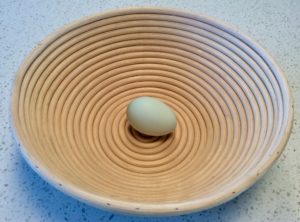It is a common occurrence in egg-laying-chickendom that hens slow down or cease laying eggs in winter. Shorter days resulting in less daylight would make anyone sluggish and long to take a break from the daily grind.
If you have a strong reliance on eggs, this season in a hen’s life can be worrisome. However, with a little planning, you can have eggs all year long with an age-diversified flock. As for your lulling layers, here are a few things you can do to support and prepare them for laying again as spring arrives.
PROPER NUTRITION
It is only natural that birds slow down their production of eggs in the winter. In nature, it would be a risk to raise their young in harsh winter weather, and egg making expends a lot of energy! This precious energy is what keeps them warm on days when temps are literally freezing.
Nutrition is important year-round but when it comes to a body’s need for recovery and survival, food is key. As laying slows, feather loss can also occur. You may not witness a hard molt but some gals will take this time to fire up their systems and replace what was lost. Because of this, protein requirements increase, along with a need for added fats. Considering the scarcity of their natural resources — namely bugs — it is up to the caregiver to provide some additions.
Although eggs may be scarce, they are a great source of natural protein and fats. Providing cooked, scrambled eggs, seasoned with a little dried oregano and cayenne pepper will help get your girls back on track quicker. Various high-protein and omega-3 rich foods such as dried mealworms, sunflower seeds, flax or wheat germ are another great addition. The fatty acids found in these foods are just as good for your chickens as they are for you! Suet blocks, ground turkey or chicken, all served with a little grit can also be part of a chicken’s food buffet dream.
Keep the carbs available for a bedtime snack. Cracked or whole corn, dried sweet corn, grapes and fruit such as blueberries are all really good things. By serving them as the sun goes down, the hens can more readily use those sugars to warm their bodies. This is an easy way you can assist them in reserving their fat stores for other things.
FLOCK AGE
Laying hens can live a healthy life for years if given the right circumstances, genetics, and nutrition. For the first 2 years of their life, egg production is at its peak. A healthy hen can lay up to 1-2 eggs per 24-36 hour period. During the first few months, eggs gradually increase in size and quality.
When the first molt occurs around 16-18 months, a drop in egg production is to be expected. As a hen enters her second year, age tends to catch up with her. Laying becomes less consistent as the body requires more time and energy to repair itself.
At some point, one has to decide if a hen will be kept as a pet or still holds enough value as a layer. If you are keeping chickens for egg production, feed costs not supporting a good egg producer simply doesn’t make sense.
Staggering your flock ages and rotating older, less producing hens out of the coop makes good financial sense. Commonly, first-year hens will keep laying eggs right on through winter. Consider adding new additions to the flock every 1-2 years.
A WORD ON SUPPLEMENTAL LIGHT
Supplying your winter coop with supplemental lighting is handy for you but not necessarily healthy for your flock. As previously mentioned, wintertime sunlight decreases gradually from late-summer to mid-winter. This reduction can trigger an alarm clock of sorts within your birds, telling them it’s time to rest and recover from the strain of a reproductive summer.
Some flock owners provide supplemental lighting to increase winter light exposure to 14-16 hours or more. This can help reduce the slow down of egg production as well as staving off the natural molting process. What this added light also contributes to is the inability of your flock to undergo a natural recovery period. For the long haul, this can affect the overall health of your birds.
Forcing ongoing production can cause your birds to lose essential body fat and muscle weight. Their bodies dig deep into their reserves as they continue to lay eggs. Furthermore, feather loss (whether by natural means or picking) does occur and with the ongoing demands of egg-laying, they have a difficult time replacing those feathers.
EGG STOCKPILE
Being prepared for less egg production gives you ample time to prepare and stockpile your egg supplies. Unwashed eggs (bloom intact) can store for months in a refrigerator. Coupled with a few first-year layers, this may be enough to get you through a sparse winter laying season.
If you require larger volumes of eggs, research methods of freezing, pickling or dehydrating your eggs. If it comes down to it, there is no harm in buying a few dozen from the local grocery store or a neighboring farm.
SUMMARY
Being prepared for nature to take its course is a big part of life on the farm. Planning ahead with new generations of bountiful layers will keep your flock productive in every season. Allowing your flock to do what it does naturally will only benefit their health. Added provisions made to support their nutritional needs will get your girls back on track before you know it!















